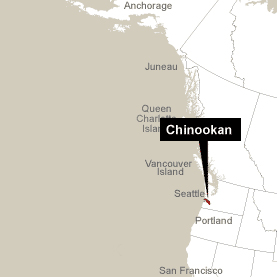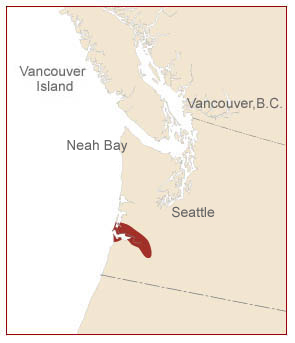
“The modern Chinook Indian Nation consists of the Clatsop and Kathlamet of what is now Oregon and the Lower Chinook, Wahkiakum and Willapa of Washington State. Our five historically important Tribes have existed since time immemorial in our aboriginal territory at the mouth of the Columbia River. It is here that our Chinook families welcomed Lewis and Clark to the Pacific Ocean and helped them survive the winter of 1805 and 1806.
The Nation’s constitution was written by the tribal leaders of these tribes in the early 1950s. The constitution outlines tribal membership criteria and clearly references five Anson Dart treaties signed by our ancestors at Tansy Point in 1851. Our constitution also one of the oldest living tribal constitutions in the Pacific Northwest.
The treaties negotiated with Mr. Dart allowed us to stay within our aboriginal territory, maintain access to resources and importantly remain in close proximity with the bones of our ancestors. We fulfilled our obligations under these treaties, but unbeknown to us at that time they were not formally ratified by the United States. That winter we suffered immensely waiting for the goods and money promised to us, but we stayed.”
Source: Text Copyright of the Chinook Nation; Chinook History, website
 “Chinookan peoples have lived on the Lower Columbia River for millennia. Today they are one of the most significant Native groups in the Pacific Northwest, although the Chinook Tribe is still unrecognized by the United States government. In Chinookan Peoples of the Lower Columbia River, scholars provide a deep and wide-ranging picture of the landscape and resources of the Chinookan homeland and the history and culture of a people over time, from 10,000 years ago to the present. They draw on research by archaeologists, ethnologists, scientists, and historians, inspired in part by the discovery of several Chinookan village sites, particularly Cathlapotle, a village on the Columbia River flood plain near the Portland-Vancouver metropolitan area.Their accumulated scholarship, along with contributions by members of the Chinook and related tribes, provides an introduction to Chinookan culture and research and is a foundation for future work.”
“Chinookan peoples have lived on the Lower Columbia River for millennia. Today they are one of the most significant Native groups in the Pacific Northwest, although the Chinook Tribe is still unrecognized by the United States government. In Chinookan Peoples of the Lower Columbia River, scholars provide a deep and wide-ranging picture of the landscape and resources of the Chinookan homeland and the history and culture of a people over time, from 10,000 years ago to the present. They draw on research by archaeologists, ethnologists, scientists, and historians, inspired in part by the discovery of several Chinookan village sites, particularly Cathlapotle, a village on the Columbia River flood plain near the Portland-Vancouver metropolitan area.Their accumulated scholarship, along with contributions by members of the Chinook and related tribes, provides an introduction to Chinookan culture and research and is a foundation for future work.”
Source: Text Copyright of the the book edited by Robert T. Boyd, Kenneth M. Ames, & Tony A. Johnson titled The Chinook Peoples of the Lower Columbia, as well as the Chinook Nation website.
